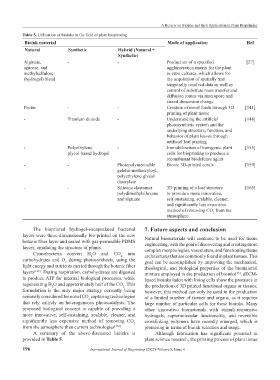Page 204 - IJB-8-4
P. 204
A Review on Bioinks and their Application in Plant Bioprinting
Table 5. Utilization of bioinks in the field of plant bioprinting.
Bioink material Mode of application Ref
Natural Synthetic Hybrid (Natural +
Synthetic)
Alginate, - - Production of a specified [27]
agarose, and agglomeration matrix for the plant
methylcellulose in vitro cultures, which allows for
(hydrogel) blend the acquisition of spatially and
temporally resolved data as well as
control of substrate mass transfer and
diffusion routes via macropore and
strand dimension change
Pectin - - Creation of novel foods through 3D [141]
printing of plant tissue
- Titanium dioxide - Understanding the artificial [148]
photosynthetic system and the
underlying structure, function, and
behavior of plant leaves through
artificial leaf printing
- Polyethylene - Immobilization of transgenic plant [155]
glycol-based hydrogel cells for bioprinting to produce a
recombinant biodefense agent
- - Photopolymerizable Bionic 3D-printed corals [159]
gelatin-methacryloyl,
polyethylene glycol
diacrylate
- - Silicone elastomer 3D printing of a leaf structure [165]
polydimethylsiloxane to provide a more innovative,
and alginate self-sustaining, scalable, cleaner,
and significantly less expensive
method of removing CO from the
2
atmosphere
The bioprinted hydrogel-encapsulated bacterial 7. Future aspects and conclusion
layers were three-dimensionally bio-printed on the new Natural biomaterials will continue to be used for tissue
botanic fiber layer and sealed with gas-permeable PDMS engineering, with the goal of discovering and creating more
layers, emulating the structure of plants. complex morphologies, vasculature, and functioning tissue
Cyanobacteria convert H O and CO into architectures that are commonly found in plant tissues. This
2
2
carbohydrates and O during photosynthesis, using the goal can be accomplished by improving the mechanical,
2
light energy and nutrients carried through the botanic fiber rheological, and biological properties of the biomaterial
layers [165] . During respiration, carbohydrates are digested mixture employed in the production of bioinks . dECM-
[15]
to produce ATP for internal biological processes, while based bioinks laden with living cells show the promises in
regenerating H O and approximately half of the CO . This the production of 3D printed functional organs or tissues;
2
2
formulation is the only major strategy currently being however, this method can only be used in the production
seriously considered for novel CO capturing technologies of a limited number of tissues and organs, as it requires
2
that rely entirely on heterogeneous photocatalysts. The large number of particular cells for these bioinks. Many
proposed biological concept is capable of providing a other innovative biomaterials with stimuli-responsive
more innovative, self-sustaining, scalable, cleaner, and hydrogels, supramolecular functionality, and reversible
significantly less expensive method of removing CO 2 crosslinking polymers have recently emerged, which is
from the atmosphere than current technologies [165] . promising in terms of bioink selection and usage.
A summary of the above-discussed bioinks is Although fabrication has significant potential in
provided in Table 5. plant science research, the printing process of plant tissue
196 International Journal of Bioprinting (2022)–Volume 8, Issue 4

